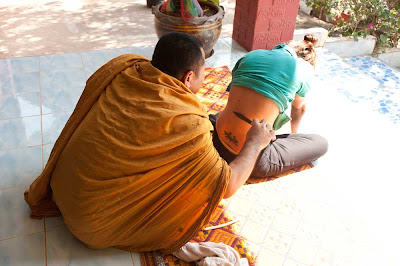 |
" Double, double toil and trouble;
Fire burn, and caldron bubble." Macbeth by W Shakespeare
|
Special merit making rituals are conducted in Isaan after a person has died and been cremated. The determining factor for when the ritual which is essentially a grand party is held is mainly economic. The ritual is held when the family can afford to pay or afford to borrow to finance the event. Since the funeral ritual is expensive, most death anniversary parties are held a year or more after the death. Recently we attended a party for two people, one who died ten years ago and the other person had died twenty years ago. The party that we attended last week was for a man who had died three months ago. He and his wife were both teachers and he had a great amount of life insurance on his life so the family was in much better financial condition than the majority of the people around here.
When we arrived, the widow greeted us and ensured that we had plenty to eat and drink. It always amazes me how gracious and hospitable Lao Loum people can be no matter the situation they find themselves in or issues that they are dealing with. Throughout our 5 hour stay at the event, she made sure that we were not in need of anything and was concerned that we were enjoying ourselves. Other family members and friends were just as welcoming and kind.
The entertainment commenced at 5:00 P.M. with traditional Morlam Lao music. Morlam Lao music is the traditional music of the Lao Loum people who reside in Lao People's Democratic Republic and Northeast Thailand. The music is typically performed with a khene, drum, and hand cymbals. The following are two links of typical music at these performances.
http://youtu.be/m0l1w6i8-dg
http://youtu.be/MVJ5iBp55Sc
Traditional Morlam Lao music was performed for about four hours. Towards the end of the traditional music portion of the show, a merit making ritual was conducted. A large saht was placed upon the stage. The widow, her children, and close family members of the deceased man knelt upon the mat. The son held a large framed photograph of the deceased man. In front of the mourners, a large tray of food offerings and a glass of Lao Lao (whiskey) was placed. The food and drink offerings are for the spirit of the deceased man.
 |
| Family Members and Performers Making Merit for Deceased Person |
 |
| Widow Grieving for her Husband |
For this merit making the ritual is along the lines of the man's past, how much he accomplished, how good a heart that he had (his kindness), how much he is missed but most importantly - his spirit now has been fed, his spirit has been refreshed with whiskey, his family is doing fine and his spirit is now free as well as released to move on with its journey. It is very moving even if you do not understand the words but observing the emotions communicates the intimacy and importance of the ritual.
As people drank more and more, they were seduced by the hypnotic rhythms of the morlam Lao music and were frequently found dancing in front of the stage. Once people found out that I knew how to dance Lao style, I was constantly being invited up to dance by both men and women. Duang was not spared either - I ended up picking her up out of her chair and carrying her out to the dance area - much to the delight of everyone.
These events are quite interesting and you never know what to fully expect. One elderly women, quite dignified, ended up to be quite bawdy. She kept getting the microphone and making comments over the large speakers. The comment that I remember best was something along the lines of "I am going to go off on a motorbike and it is going to feel very good because I have a small %^&&#" Rather than being shocked, people laughed like crazy. The men were not to be out done. A brother to the deceased man was quite drunk but was very entertaining.
During performances at these shows, people will approach the edge of the stage and give money to the performers. Sometimes if people do not have money they will just shake the hands of the performer and state their appreciation. At some events, flowers or paper garlands are offered. At the party that we attended last week, the deceased man's brother had plenty of money. He was given money by the family and was the designated person to distribute the money to each of the performers. He did a good job until he drank too much. He stopped giving away the money. Either his sister or wife noticed and confronted him out in the middle of the dance area. She was talking rather loudly at him. She checked the pockets on his vest and pulled out a wad of cash. Everyone roared with laughter. He made amends and recommenced distributing the cash. When he ran out of money, he gave a piece of paper to the female singer. According to Duang the paper said something along the lines of when you get to be as old as me (65 years old) perhaps we could get together. Apparently he forgot that at that time he would be around 90 years old! Over the microphone, the singer said "One time with me will probably kill you!" Everyone laughed like crazy. The man did not get angry and concentrated on his dance routines.
 |
| Dancer Performing to Morlam Ziang Music |
 |
| Dancer Performing A Classic Dance Move - Pelvic Thrust |


















































